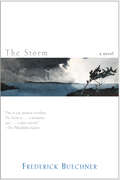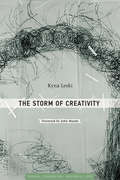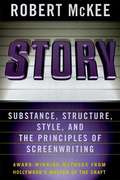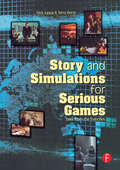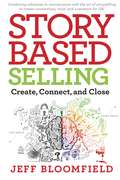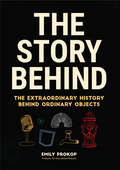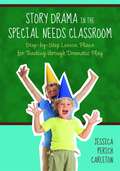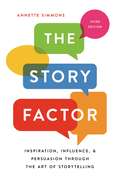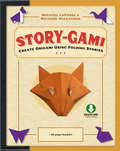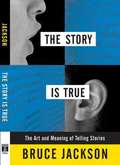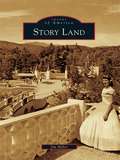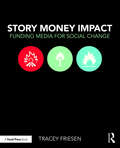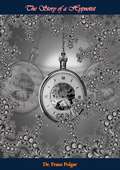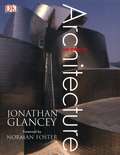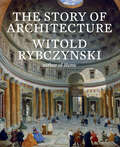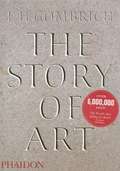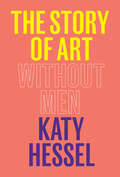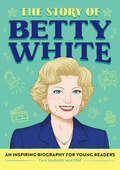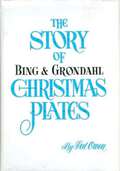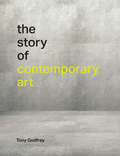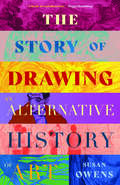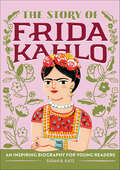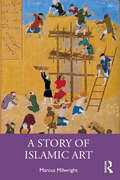- Table View
- List View
The Stories Shoes Tell (Fountas & Pinnell LLI Purple #Level U)
by Nancy WhiteShoes talk. From athletic shoes to five-inch heels, from baseball cleats to flip-flops, the kinds of shoes people wear say a lot about who they are and who they want to be. Even shoes from thousands of years ago have stories to tell about the people who wore them.
The Storm: A Novel
by Frederick BuechnerThe Boston Globe calls Frederick Buechner "one of our finest writers." USA Today says he's "one of our most original storytellers." Now this acclaimed author gives us his most beguiling novel yet--a magical tale of love, betrayal, and redemption inspired by Shakespeare's The Tempest.On wealthy Plantation Island in South Florida, an old man waits, Kenzie Maxwell is a writer, a raconteur, a rascal, an altruist, a mystic--a charismatic figure who enjoys life with his rich third wife but muses daily on the sins of his past. Two decades ago, Kenzie had to leave New York because of a scandal. He'd been a volunteer at a runawat shelter, and he'd fallen in love with a seventeen-year-old girl--a girl who died while giving birth to Kenzie's daughter. His older brother, Dalton, a lawyer and board member at the shelter, decided to quell the rumors by releasing Kenzie's note of apology to the press. Kenzie's reputation--and the girl's--were destroyed. He has never forgiven his brother.Now it's the eve of Kenzie's seventieth birthday, and a storm is brewing. His beloved daughter, Bree--the child of the scandal--is coming down from New York for his birthday party. But his brother Dalton is coming down, too, to do some legal work for the island's ill-tempered matriarch. Aided and abetted by Dalton's happy-go-lucky stepson, a loutish gardener, a New Age windsurfer, a bumbling bishop, and a bona fide tempest, Kenzie must somehow contrive to reconcile with his brother--and make peace with his past.Infused with humanity, and informed by faith. The Storm is Frederick Buechner's most captivating novel since Godric--a richly satisfying contemporary story of fragmented families and love's many mysteries that will move you, makeyou laugh, and fill you with wonder.
The Storm of Creativity (Simplicity: Design, Technology, Business, Life)
by Kyna LeskiThe stages of the creative process—from “unlearning” to beginning again—seen through examples from the practice of artists, architects, poets, and others. Although each instance of creativity is singular and specific, Kyna Leski tells us, the creative process is universal. Artists, architects, poets, inventors, scientists, and others all navigate the same stages of the process in order to discover something that does not yet exist. All of us must work our way through the empty page, the blank screen, writer's block, confusion, chaos, and doubt. In this book, Leski draws from her observations and experiences as a teacher, student, maker, writer, and architect to describe the workings of the creative process. Leski sees the creative process as being like a storm; it slowly begins to gather and take form until it overtakes us—if we are willing to let it. It is dynamic, continually in motion; it starts, stops, rages and abates, ebbs and flows. In illustrations that accompany each chapter, she maps the arc of the creative process by tracing the path of water droplets traveling the stages of a storm.Leski describes unlearning, ridding ourselves of preconceptions; only when we realize what we don't know can we pose the problem that we need to solve. We gather evidence—with notebook jottings, research, the collection of objects—propelling the process. We perceive and conceive; we look ahead without knowing where we are going; we make connections. We pause, retreat, and stop, only to start again. To illustrate these stages of the process, Leski draws on examples of creative practice that range from Paul Klee to Steve Jobs, from the discovery of continental drift to the design of Antoni Gaudí's Sagrada Familia. Creativity, Leski tells us, is a path with no beginning or end; it is ongoing. This revelatory view of the creative process will be an essential guide for anyone engaged in creative discovery. The Creative Process Unlearning Problem Making Gathering and Tracking Propelling Perceiving and Conceiving Seeing Ahead Connecting Pausing Continuing
Story: Style, Structure, Substance, and the Principles of Screenwriting
by Robert MckeeRobert McKee's screenwriting workshops have earned him an international reputation for inspiring novices, refining works in progress and putting major screenwriting careers back on track. Quincy Jones, Diane Keaton, Gloria Steinem, Julia Roberts, John Cleese and David Bowie are just a few of his celebrity alumni. Writers, producers, development executives and agents all flock to his lecture series, praising it as a mesmerizing and intense learning experience. In Story, McKee expands on the concepts he teaches in his $450 seminars (considered a must by industry insiders), providing readers with the most comprehensive, integrated explanation of the craft of writing for the screen. No one better understands how all the elements of a screenplay fit together, and no one is better qualified to explain the "magic" of story construction and the relationship between structure and character than Robert McKee.
Story and Simulations for Serious Games: Tales from the Trenches
by Nick Iuppa Terry BorstHow to create a simulation where participants have a sense of freedom and personal control while still maintaining the structure necessary for an effective story is a difficult task indeed. This book examines how to create an engaging, effective story (necessary to teach participants), while relating practical considerations of building a simulation. It also looks at stories as classic ways of teaching and gathering knowledge and considers other theories of interactive narrative design such as synthetic story creation and management and participant-generated story experiences. It also discusses enabling technologies in artificial intelligence, synthetic characters design and development, speech recognition technology, 3D modelling, and the future of story-driven games. Story Driven Simulations reviews the existing efforts in this field as well as focusing on the recent efforts of Paramount Pictures and The Institute for Creative Technologies at the University of Southern California, where this expert author team created successful simulations for the U.S. Army, Department of Defense, as well as other educational simulations.
Story Based Selling
by Jeff BloomfieldAs a founder of a successful organization that trains and develops sales professionals, Jeff Bloomfield has given a lot of thought to why customers say yes. In Story-Based Selling: Create, Connect, and Close, Mr. Bloomfield says it's really no mystery. People buy from people they trust. They trust people they like, and they like people they connect to. And he believes that storytelling is the best way for salespeople-and all of us-to immediately connect to a customer's feelings of trust and liking. He thinks teaching sales professionals to close a deal by presenting their product, probing its mutual benefits, and overcoming the customer's objections and skepticism, is a waste of time. Instead, he urges them to tell a great story. Mr. Bloomfield calls upon the latest research in neuroscience to explain the process of communication. The truth is that during the salesperson's engagement with clients, people quickly base their decisions on how they feel, not the way they think, so trying to persuade someone by first imparting lifeless facts and figures is self-defeating. In fact, this information goes right to an area of the listener's brain (the left brain) that drives doubt and skepticism. To make a deal we need to connect with the parts of the customer's brain that inspire emotions of trust and empathy. By telling a story, we can immediately connect to these good gut feelings and drive away the client's fear of being sold. Mr. Bloomfield tells his own engaging stories while teaching step-by-step techniques of intentional storytelling-to create a fast connection with the listener, no matter who is buying or what a person wants to sell.
The Story Behind: The Extraordinary History Behind Ordinary Objects (Story Behind Ser.)
by Emily ProkopLearn the fascinating history and trivia behind the everyday items we take for granted—from the host of the popular podcast The Story Behind. Many of us learn about the major inventions that shape our world. But we too often overlook the objects we use every day. In The Story Behind, Emily Prokop, creator of the Webby Award nominated podcast, explores the who, how, and huh? of everything from Band-Aids to bubble gum; hypnosis to Hula Hoops; and lullabies to lead pipes. Along the way, she demonstrates how the major events of history—from wars, plagues, and revolutions to historic achievements and discoveries—have influenced some of the world&’s most pervasive inventions. Revealing fascinating new details on topics covered in the podcast, the book also explores many new subjects. Learn how lollipops got started in ancient Egypt, how Kevlar came to be, and why Comic Sans was created. Learn the torture device origins of certain exercise equipment and how some musical instruments were first developed for espionage. From food, fashion, and games to transit and modern technology, The Story Behind offers a closer look at the things closest to us.
The Story Factor: Inspiration, Influence, and Persuasion through the Art of Storytelling
by Annette SimmonsFully revised, updated, and expanded, this modern classic will teach you to use the art of storytelling to persuade, motivate, and inspire in life and business Anyone seeking to influence others must first know their own story, and how to tell it properly. Whether you're proposing a risky new venture, trying to close a deal, or leading a charge against injustice, you have a story to tell. Tell it well and you will create a shared experience with your listeners that can have profound results.In this modern classic, Annette Simmons reminds us that the oldest tool of influence is also the most powerful. Fully revised and updated to account for new technology and social media, along with two new chapters on the role of stories in the development of civilization and how to adjust your story to your specific goal, Simmons showcases over a hundred examples of effective storytelling drawn from the front lines of business and government, as well as myths, fables, and parables from around the world. Whether writing a screenplay, or announcing a corporate reorganization, Simmons illustrates how story can be used in ways that cold facts, bullet points, and directives can't. These stories, combined with practical storytelling techniques, show anyone how to become a more effective communicator and achieve their goals.
Story-gami
by Michael G. Lafosse Richard L. AlexanderAct out cute stories while you fold origami projects with this unique and easy origami.The joy in folding origami is often found in the deceptively simple magic of transforming a single piece of paper into a recognizable object. All too often, the steps it takes to transform paper into origami designs can be frustrating.Story-gami is an innovative new paper craft ebook from world renowned origami artists, Michael G. LaFosse and Richard L. Alexander who have created entire storylines around characters Righty and Lefty and their adventures climbing mountains, going on boat rides, and hanging out with bunnies. Each story's end results in a finished piece of origami, like an elegant butterfly, a jumping frog or a flapping bird and allowing anyone to discover the magic in creating something beautiful out of a simple piece of paper. Through the mnemonic of storytelling, LaFosse and Alexander make origami paper folding easy for those with any level of skill and a whole lot of fun. The unique method of storytelling makes this a great origam-for-kids and an excellent way to learn orgami.This origami ebook includes: Full color, 80-page origami book Clear step-by-step instruction and diagrams18 fun origami projectsDownloadable video files Story-gami is unlike any other origami ebook. Children will love acting out the stories in the book as the fold their new origami creations!Origami projects include: Penguin Tulip Plant With Blossom Tabletop Racing Duck Fortune Cookie Box Kanji The Dog And many more...
The Story Is True: The Art and Meaning of Telling Stories
by Bruce JacksonMaking and experiencing stories, remembering and retelling them is something we all do. We tell stories over meals, at the water cooler, and to both friends and strangers. But how do stories work? What is it about telling and listening to stories that unites us? And, importantly, how do we change them-and how do they change us? InThe Story Is True, author, filmmaker, and photographer Bruce Jackson explores the ways we use the stories that become a central part of our public and private lives. He examines, as no one before has, how stories narrate and bring meaning to our lives, by describing and explaining how stories are made and used. The perspectives shared in this engaging book come from the tellers, writers, filmmakers, listeners, and watchers who create and consume stories. Jackson writes about his family and friends, acquaintances and experiences, focusing on more than a dozen personal stories, from oral histories, such as conversations the author had with poet Steven Spender, to public stories, such as what happened when Bob Dylan "went electric"at the 1965 Newport Folk Festival. Jackson also investigates how "words can kill," showing how diction can be an administrator of death, as in Nazi extermination camps. And finally, he considers the way lies come to resemble truth, showing how the stories we tell, whether true or not, resemble truth to the teller. Ultimately,The Story Is Trueis about the place of stories-fiction or real-and the impact they have on the lives of each one of us.
Story Land
by Jim MillerWhen sedans and station wagons replaced trains for vacationers heading to New Hampshire's rugged and picturesque White Mountains, new motels and attractions catering to middle-class families sprang up amidst the established grand hotels and diversions for socialites, artists, skiers, and hikers. In 1954, a tiny children's park inspired by a collection of storybook dolls opened in the quiet village of Glen. Through a unique combination of independent innovation and regional cooperation, Story Land has continually grown for more than 50 years through economic and cultural changes that undermined many amusement parks. Parents still travel great distances for a Story Land getaway with their children, just as their own parents did, sharing a common experience that is talked about between multiple generations at family gatherings. This photograph collection illustrates the unlikely beginnings and creative entrepreneurship behind one of New England's most memorable and enduring childhood institutions.
Story Money Impact: Funding media for social change
by Tracey FriesenStory Money Impact: Funding Media for Social Change by Tracey Friesen is a practical guide for media-makers, funders, and activists who share the common goal of creating an impact with their work. Today, social-issues storytellers are sharpening their craft, while funders with finite resources focus on reach, and strategic innovators bring more robust evaluation tools. Friesen illuminates the spark at the core of these three pursuits. Structured around stories from the front lines, Story Money Impact reveals best practices in the areas of documentary, digital content, and independent journalism. Here you will find: • Twenty-one stories from people behind such powerful works as CITIZENFOUR, The Corporation, Virunga, Being Caribou, Age of Stupid, and Food Inc. • Six key story ingredients for creating compelling content. • Six possible money sources for financing your work. • Six impact outcome goals to further your reach. • Seven practical worksheets for your own projects. • A companion website located at www.storymoneyimpact.com containing up-to-date information for those seeking the tools and inspiration to use media for social change.
The Story of a Hypnotist
by Dr Franz Polgar Kurt Singer"Dr. Franz Polgar (April 18, 1900 - June 1979) was a renowned psychologist, hypnotist, lecturer and entertainer. Born in city of Enying, Hungary, he earned a PhD in Psychology from the University of Budapest. In his 1951 autobiography Polgar claimed that he had served as Sigmund Freud's "medical hypnotist" (Polgar's term) in 1924 and had worked in close association with Freud for six months and had assisted in the treatment of Freud's patients. He immigrated to the United States in 1935 and honed his hypnotism skills by working in speakeasy bars in New York City. He married his wife, Lillian, in 1938 and she became his booking and publications manager. They had two children, Julian and Risa."
The Story Of Architecture
by Jonathan GlanceyGuiding readers through a staggering 5,000 years of world architecture, Jonathan Glancey's eminently knowledgeable, authoritative, and always fascinating insights make reading this book irresistible, despite the enormity of the subject. Featuring influential and innovative architects of every age, along with their masterpieces, from the ziggurat at Ur to the Guggenheim Museum in Bilbao, this stylish, lavishly illustrated book shows the unique historical, geographical, and cultural elements that have influenced and literally shaped the world's greatest architecture.
The Story of Architecture
by Witold RybczynskiAn inviting exploration of architecture across cultures and centuries by one of the field’s eminent authorsIn this sweeping history, from the Stone Age to the present day, Witold Rybczynski shows how architectural ideals have been affected by technological, economic, and social changes—and by changes in taste. The host of examples ranges from places of worship such as Hagia Sophia and Brunelleschi’s Duomo to living spaces such as the Katsura Imperial Villa and the Alhambra, national icons such as the Lincoln Memorial and the Sydney Opera House, and skyscrapers such as the Seagram Building and Beijing’s CCTV headquarters. Rybczynski’s narrative emphasizes the ways that buildings across time and space are united by the human desire for order, meaning, and beauty. This is the story of architecture’s physical manifestation of the universal aspiration to celebrate, honor, and commemorate, and an exploration of the ways that each building is a unique product of patrons, architects, and builders. Firm in opinion, even-handed, and rooted in scholarship, this book will delight anyone interested in understanding the buildings they use, visit, and pass by each day.
The Story of Art (16th edition)
by E. H. GombrichThis text is the 16th revised and updated edition of this introduction to art, from the earliest cave paintings to experimental art. Eight new artists from the modern period have been introduced. They are: Corot, Kollwitz, Nolde, de Chirico, Brancussi, Magritte, Nicolson and Morandi. A sequence of new "endings" have been added, and the captions are now fuller, including the medium and dimension of the works illustrated. [This text is listed as an example that meets Common Core Standards in English language arts in grades 9-10 at http://www.corestandards.org.]
The Story of Art Without Men
by Katy HesselThe story of art as it’s never been told before, from the Renaissance to the present day, with more than 300 works of art. <p><p>How many women artists do you know? Who makes art history? Did women even work as artists before the twentieth century? And what is the Baroque anyway? <p><p>Guided by Katy Hessel, art historian and founder of @thegreatwomenartists, discover the glittering paintings by Sofonisba Anguissola of the Renaissance, the radical work of Harriet Powers in the nineteenth-century United States and the artist who really invented the “readymade.” Explore the Dutch Golden Age, the astonishing work of postwar artists in Latin America, and the women defining art in the 2020s. Have your sense of art history overturned and your eyes opened to many art forms often ignored or dismissed. From the Cornish coast to Manhattan, Nigeria to Japan, this is the history of art as it’s never been told before. <p> <b>New York Times Bestseller</b>
The Story of Betty White: An Inspiring Biography for Young Readers (The Story of Biographies)
by Tam MintonDiscover the life of Betty White—a story about confidence, imagination, and being silly for young readers ages 6 to 9Betty White was a comedian, producer, and TV star. Before she became famous, she was a little girl in California who loved animals and wanted to be a park ranger. She worked hard to become one of the first women to star in her own TV show, and played many characters who did things differently. Explore how she went from driving trucks during World War II, to being a beloved celebrity—even into her nineties!Independent reading—This Betty White biography is broken down into short chapters and simple language so young readers 6 to 9 can learn on their own.Critical thinking—Kids will learn the Who, What, Where, When, Why, and How of Betty's life, find definitions of new words, discussion questions, and more.A lasting legacy—Find out how Betty's kindness, curiosity, and daring made her a talented performer and inspired others to change their thinking.How will Betty's bravery and humor inspire you?Discover activists, artists, athletes, and more from all across history with the rest of the Story Of series, including famous figures like: Amelia Earhart, Jane Goodall, Eliza Hamilton, Simone Biles, and Misty Copeland.
The Story of Bing And Grondahl Christmas Plates
by Pat Owen Ole SimonsenCreated in 1895, the idea of Christmas plate originated with Harald Bing, owner of Bing & Grøndahl, who hired Swedish artist Frans August Hallin to create the motif. Hallin's technique of cutting the motif for the plate in relief created a very detailed expression. The first motif was the Copenhagen skyline.“Many, many years ago the wealthy people of Europe started a Christmas custom of giving to each of their servants a platter heaped with fruit, cookies, candies and other good things to eat. At first the platter was probably a crude thing of wood, and very little thought was given to it. The rich focused their attention on the contents of the tray, hoping to bring a little cheer into the lives of the recipients by giving them especially good things to eat around the holiday season.The servants looked forward each Christmas to receiving their gifts. Since these people had few things in their homes which were not utilitarian, perhaps it was only natural that they began hanging the platters on their walls after the food was eaten. They referred to these platters as their “Christmas Plates.”Later the servants of one family started showing their Christmas Plates to the servants of other households. When the employers realized that there was rivalry among the servants of the various households regarding who received the most beautiful plates, they began giving more consideration to the platter itself. Eventually beautiful platters were made of many materials, such as metal, wood and pottery. They were sometimes elaborately carved or decoratively painted. In fact, the wealthy, in an effort to outdo each other, commenced devoting more attention to the plate itself than to its contents. Later they started dating each platter so that it would be easy to see which year each had been given. Thus began the custom of making and collecting Christmas Plates.”-Preface
The Story of Contemporary Art
by Tony GodfreyAn instant classic--a lively new introduction to contemporary art that stretches from Andy Warhol's Brillo boxes to Marina Abramović's performance art to today's biennale circuit and million-dollar auctions.Encountering a work of contemporary art, a viewer might ask, "What does it mean?" "Is it really art?" and "Why does it cost so much?" These are not the questions that E. H. Gombrich set out to answer in his magisterial The Story of Art. Contemporary art seems totally unlike what came before it, departing from the road map supplied by Raphael, Dürer, Rembrandt, and other European masters. In The Story of Contemporary Art, Tony Godfrey picks up where Gombrich left off, offering a lively introduction to contemporary art that stretches from Andy Warhol's Brillo boxes to Marina Abramović's performance art to today's biennale circuit and million-dollar auctions. Godfrey, a curator and writer on contemporary art, chronicles important developments in pop art, minimalism, conceptualism, installation art, performance art, and beyond.
The Story of Drawing: An Alternative History of Art
by Susan OwensDrawing is at the heart of human creativity. The most democratic form of art-making, it requires nothing more than a plain surface and a stub of pencil, a piece of chalk or an inky brush. Our prehistoric ancestors drew with natural pigments on the walls of caves, and every subsequent culture has practised drawing – whether on papyrus, parchment or paper. Artists throughout history have used drawing as part of the creative process.While painting and sculpture have been shaped heavily by money and influence, drawing has always offered extraordinary creative latitude. Here we see the artist at his or her most unguarded. Susan Owens offers a glimpse over artists&’ shoulders – from Michelangelo, Rembrandt and Hokusai to Van Gogh, Käthe Kollwitz and Yayoi Kusama – as they work, think and innovate, as they scrutinise the world around them or escape into their imaginations.The Story of Drawing loops around the established history of art, sometimes staying close, at other times diving into exhilarating and altogether less familiar territory.
The Story of Frida Kahlo: An Inspiring Biography for Young Readers (The Story Of)
by Susan B. KatzDiscover the life of Frida Kahlo—a story about strength, creativity, and never giving up for kids ages 6 to 9Frida Kahlo is one of the most famous and celebrated artists who has ever lived. Before she made history with her beautiful paintings and brave spirit, she went through a life-changing accident that would have made many people want to give up. Instead, Frida fought to overcome her setbacks and follow her passions. In this Frida Kahlo children's book, you'll explore how Frida went from being a young girl in a small Mexican town to an artist who is beloved all around the world.Independent reading—This Frida Kahlo biography is broken down into short chapters and simple language so kids 6 to 9 can read and learn on their own.Critical thinking—Kids will learn the Who, What, Where, When, Why, and How of Frida's life, find definitions of new words, discussion questions, and more.A lasting legacy—Find out how Frida inspired the world with her unique and colorful paintings, as well as her strength of character. How will Frida's creativity and can-do attitude inspire you?Discover activists, artists, athletes, and more from across history with the rest of the Story Of series, including famous figures like: Marie Curie, Selena Quintanilla, Amelia Earhart, Helen Keller, and Jane Goodall.
A Story of Islamic Art
by Marcus MilwrightProviding an introduction to the artistic and architectural traditions of the Islamic world, A Story of Islamic Art explores fifty case studies, taken from different regions of the Islamic world and from the seventh to the twenty-first centuries. The novel aspect of these case studies is that they are presented as fictional narratives, allowing the reader to imagine art and architecture, either in their original cultural settings or at some later point in their histories. These stories are supported by a scholarly framework that allows the reader to continue their exploration of the chosen artefacts and their historical context. The fifty case studies take the form of short stories, each of which focuses on one or more object from the Islamic world. These encompass portable items in a wide variety of media, book illustrations, calligraphy, photographs, architectural decoration, buildings, and archaeological sites. The book also provides a detailed introduction, maps, timeline, glossary, and guides for further reading. This book offers accessible answers to key questions in the scholarship on Islamic art and architecture from its earliest times to the present. The issues dealt with in each of the stories include iconography, attitudes towards representation, the role of script, the elaboration of geometric decoration, the creation of sacred and secular spaces in architecture, and the socio-cultural context of art production and consumption. Artistic interactions between the Islamic world and other regions including Europe and China are also discussed in this book. A Story of Islamic Art is an engaging and informative introduction for interested readers and students of Islamic art, history, and architecture.

